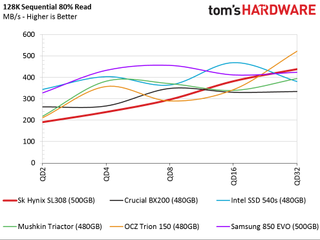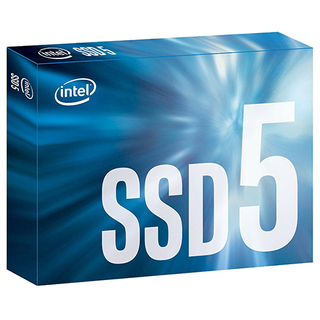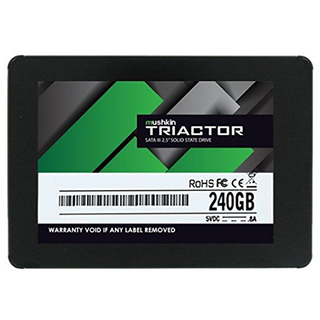SK hynix SL308 SSD Review - LAMD Goes TLC
SK hynix has a hot, new, low-cost SSD that looks amazing and performs well with TLC flash.
Why you can trust Tom's Hardware
Benchmarks And Comparisons
Comparison Products
The comparison products represent today's entry-level SSD market. All of the products utilize three-bit-per-cell flash; multi-level-cell-flash is now the domain of mainstream and premium-class SSDs. You'll see TLC technology penetrate deeper into the mainstream space as soon as IMFT releases its 384-bit 3D TLC NAND.
Samsung's 850 EVO is the current market leader, priced between most entry-level and mainstream products. The company recently released its 750 EVO 500GB and transitioned the entire product family from OEM and system integrator to retail. In the coming months, we will add the 750 EVO to our entry-level SSD charts and remove the 850 EVO.
Two new products join the entry-level list: the Intel SSD 540s (Silicon Motion SM2258) and Mushkin Triactor (Phison S10). They join the Crucial BX200 and OCZ Trion 150.
To read about our storage tests in-depth, please check out How We Test HDDs And SSDs. Four-corner testing is covered on page six of our How We Test guide.
Sequential Read Performance


All of the drives on the chart read sequential data well. TLC memory facilitates similar performance as MLC when it's caged by the SATA 6Gb/s interface's ceiling. Really, processor architecture and firmware contribute more to this specific workload.
The SL308 ranks third on our list in large-block sequential reads. It's fast enough to satisfy gamers, casual PC users, and even some enthusiasts.
Sequential Write Performance



The SL308 acts more like Samsung's 850 EVO when it's writing data sequentially than the SSDs sporting Toshiba and Micron TLC NAND. It takes a tougher task to push the drive down to the native speed of its TLC flash. We can see that SK hynix implements a highly capable emulated SLC buffer algorithm, just like Samsung. In short, when you install games or transfer large files, the SL308 won't slow down as soon as some other TLC-based SSDs.
Random Read Performance



The SL308 follows closely behind the 850 EVO 500GB in small-block random reads at a queue depth of one. It scales well from there, and mimics Samsung's 850 EVO all the way to QD4, which is typical of the most demanding desktop workloads.
Random Write Performance



The SL308 SSD outperforms everything except Samsung's contender in small-block random writes. It has a more difficult time scaling up to high IOPS at low queue depths, but finishes the test strong.
SK hynix put together one of, if not the best planar TLC flash-based SSDs available according to our synthetic corner-case workloads. Let's see if the same holds true in our mixed benchmarks.
80 Percent Sequential Mixed Workload
We describe our mixed workload testing in detail here, and describe our steady state tests here.

The SK hynix SL308 performs well in the four-corner tests, but falls flat in the two mixed-workload metrics. These sequential numbers with 128KB blocks are similar to what we were getting from SSDs a few years ago. After we started focusing on real-world application and mixed-workload performance, companies started tuning their firmware for these more realistic blends. Fast-forward to 2016, and even Intel talks about the importance of mixed workloads (Intel SSD 540s Product Brief).
80 Percent Random Mixed Workload

The results of our two mixed-workload tests lead us to believe that SK hynix has not optimized this controller yet for these hybrid blends. Clearly, the SL308 delivers Samsung-like performance in many of our corner cases. But if the drive were tuned for mixed workloads, it'd only be slightly behind Samsung's 850 EVO here, too. SK hynix could address mixed-workload performance in a future firmware update. A stronger focus on 80/20 and 70/30 performance could yield a better end-user experience.
Sequential Steady-State



The sequential steady-state test with mixed workloads highlights two points we've already touched on. The first is low 70/30 and 80/20 mixed-workload performance. The second is how fast SK hynix 16nm planar TLC flash can be during data writes.
Random Steady-State


With the exception of the 850 EVO's random 4KB steady-state results, SK hynix delivers higher and more consistent performance than the other products on our chart. The SL308 takes longer to degrade, which we see from the early and latter parts of the second chart. The fact that it behaves so well for so long demonstrates good flash management in this worst-case workload.
Current page: Benchmarks And Comparisons
Prev Page Specifications And Features Next Page Software Performance And ConclusionStay On the Cutting Edge: Get the Tom's Hardware Newsletter
Join the experts who read Tom's Hardware for the inside track on enthusiast PC tech news — and have for over 25 years. We'll send breaking news and in-depth reviews of CPUs, GPUs, AI, maker hardware and more straight to your inbox.

US attacks China's Quantum research, spy balloons by adding 37 companies to ban list — Entity List aggressively targets potential military applications

Blacklisted China chipmaker SMIC becomes the world's second-largest pure-play foundry by revenue — outsells GlobalFoundries and others

Latest AMD Strix Point leak highlights monster 120W TDP and 64GB RAM limit
-
anbello262 Im definitely waiting to see if that optimization it lacks is ever implemented by firmware.Reply
If it is (and a new benchmark proves it), it could easily dethrone the 850 as the most recommended product. -
Sakkura I wish you'd compared it with the Sandisk Ultra II. That's been one of my go-to recommendations between the 850 Evo and the budget TLC drives. The SL308 looks like a similar kind of product.Reply -
littleleo Started selling these in place of the SanDisk X400 models because of the WD/SanDisk fake shortage and mega price increase. Everyone that has tried them has been very happy with their performance. Very close to Samsung 850 Evo in performance yet one of the best price points available if they only made a 1TB model.Reply -
helopilot I'd like to see how this drive compares against the Sandisk X400. TomsHardware has yet to review the Sandisk X400. What's up with that?Reply -
littleleo I've been selling both brands, and the SK Hynix competes very well against the SanDisk X400. Since WD/SanDisk created a shortage in the X400 models and raised prices at the beginning of this month. The SK Hynix has the edge in pricing from around $11 to $25 depending on the model. The SK Hynix seems faster on most specs except for the Seq. write specs. The SanDisk X400 does offer a 5 year warranty to the SK Hynix 3 warranty. For now pricing and good stock it makes the SK Hynix a very nice replacement for the SanDisk X400.Reply -
anbello262 Can I have some more info on that 'fake shortage'?Reply
Sounds like an interesting piece of information. -
LordConrad LAMD controllers are very good, but I refuse to use TLC NAND that is manufactured at less than 20nm. For me, it's MLC drives or the Samsung EVO.Reply -
Nintendork Finally a drive that gives the EVO a run for it's money.Reply
Samsung 850 EVO
SK Hynix SL308
Kingston HyperX Savage



